#somerville public library
Text
A sensible hate speech policy that takes into account the First Amendment, but also the safety of library patrons and library workers.
#libraries#public libraries#American libraries#Somerville Massachussetts#Somerville Public Library#hate speech#freedom of speech#libraries and freedom of speech#codes of conduct
3 notes
·
View notes
Text
Mary Somerville, the world's first scientist.


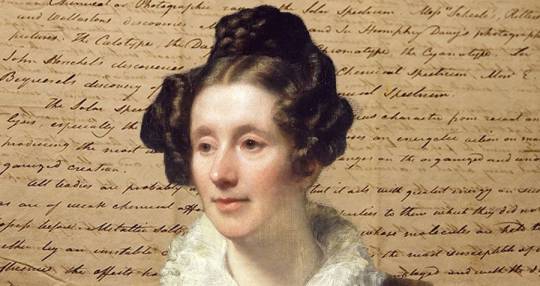

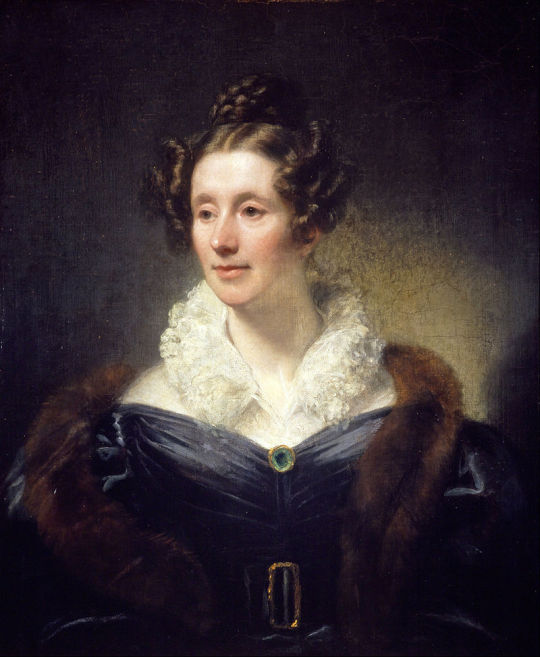
On December 26th 1780 Mathematician and scientist,Mary Somerville was born in Jedburgh.
Before Mary Sommerville came around, the word "scientist" didn't even exist.
When we think of history’s great scientists, names such as Isaac Newton, Galileo Galilei, or Nicolaus Copernicus likely come to mind. The funny thing is that the term “scientist” wasn’t coined until 1834 — well after these men had died — and it was a Scottish woman named Mary Somerville who brought it into being in the first place.
Mary Somerville was an almost entirely self-taught polymath whose areas of study included math, astronomy, and geology – just to name a few. That Somerville had such a constellation of interests, and possessed two X chromosomes, would signal a need to create a new term for someone like her — and scientific historian William Whewell would do precisely that upon reading her treatise, On the Connexion of the Physical Sciences, in 1834.
After reading the 53-year-old Somerville’s work, he wanted to pen a glowing review of it. He encountered a problem, however: The term du jour for such an author would have been “man of science,” and that just didn’t fit Somerville.
In a pinch, the well-known wordsmith coined the term “scientist” for Somerville. Whewell did not intend for this to be a gender-neutral term for “man of science;” rather, he made it in order to reflect the interdisciplinary nature of Somerville’s expertise. She was not just a mathematician, astronomer, or physicist; she possessed the intellectual acumen to weave these concepts together seamlessly.
Somerville was an intellectual giant of her age. In her mathematical and scientific pursuits, she was able to converse confidently with some of the foremost minds in the natural philosophic community (natural philosophy previously having been the name of scientific endeavour). More so, she was able to do this without attending university, instead acquiring knowledge through her own self-teaching abilities.
Growing up in a lower middle-class household in Scotland, she received a basic education — though this was not any more than was expected of a girl at the time. It was only due to her boundless curiosity in the world around her which she cultivated through various countryside excursions, and through reading the books in her father’s private library, that she was given the spark that became a lifelong love of knowledge and explanation.
As her early academic interests, perceived as boyish, were shunned in the household, she was sent to learn needlework and domestic duties (both of which she met with annoyance). She still attempted to keep up with the more extensive education that boys in her town were provided with (and indeed often surpassed them).
As a maturing young woman of 18, she was introduced into society: attending balls and spectacles in Edinburgh and dancing with nobility. She was outwardly renown as a beauty and was married in 1804 to a wealthy physician.
With her free time as a provincial housewife, she now began to study seriously and continued this after she became a widow three years later. She read the works of Newton, Laplace, Lagrange, and others scientific notables.
By her early thirties, she was solving complex problems and publishing her results in philosophical journals of the time. For this she received awards and public notoriety.
An incredible polymath, she was adept in almost all areas of scientific pursuit. Her interests were so multi-varied and her abilities so keen that she was able to become knowledgeable in mathematics, physics, chemistry, geology, geography, and astronomy, as shown in the vast scope of her publications.
Her works On the connexion of the physical sciences’ and ‘Physical Geography remained staples years after her death. She was also able to speak Latin and Ancient Greek fluently. Biographer Renee Bergland claimed that ‘she was no mere astronomer, physicist, or chemist, but a visionary thinker’, and one who surmounted daunting mental obstacles
Beyond purely academic interests, she somehow also found time to push her political beliefs and aided in the fight to improve the rights of women. John Stuart Mill presented Somerville with his 1868 parliamentary petition for women’s suffrage — of which she provided the first signature.
She eventually became an image in her own right, espousing the ability of women to improve their situation through intellectual pursuit — to gain an equal footing with men in that regard would later be intrinsic to suffragist efforts. Even more so in her long list of achievements, she was tutor to another giant of mathematical science: Ada Lovelace, a pioneering force in computer mechanics.
As shown, Somerville’s life encapsulated so diverse a litany of achievement and she should act as testament to the power of knowledge to break down barriers. Her legacy was so great that her name was given to an Oxford College, one that was among the first to allow women to attend the ancient university. Among the names of those who helped push women’s liberation, she must be ranked as one of the foremost, though this is not understate her incredible scientific achievement. Certainly, the true testament to her legacy came in her obituary which read: ‘whatever difficulty we might experience in the middle of the nineteenth century in choosing a king of science, there could be no question whatever as to The Queen of Science.
469 notes
·
View notes
Note
Hi Marzi!
I'm visiting Boston for the first time in a couple weeks! I was wondering if you had some recommendations for museums for another goth historical fashion minded person? Or neat cemeteries? I'd love to hear your preferences instead of a google search, if you would like to share. Thanks!
Cemeteries! We've got 'em. Highlights include King's Chapel, the Granary Burying Ground, Copp's Hill, the one on the Common, and Mount Auburn if you have time to get out into Cambridge. King's Chapel and Old North also have crypts, if you can get a tour thereof. THey do offer them; I just don't know the schedule.
Go see the Fashioning Sargent exhibit at the MFA, which is all about the clothing used in the famous Gilded Age portraits of John Singer Sargent, and the MFA in general. The Isabella Stewart Gardner Museum is also amazing. Can't recommend the Gibson House enough- a house museum from 1860, and the perfect backdrop for goth photoshoots (just be nice to the tour guide and don't lag behind!). Not sure if the Nichols House is open year-round; I know Otis isn't, which is a pity. Those are both late 18th-early 19th century.
Check out the Public Library, too. The interior is incredible. Wander Beacon Hill soaking up the historical beauty. Try to get to Sewfisticated in Somerville for excellent deals on natural-fiber fabrics; you'll thank me when you get there, plus there's a four-story antique mall nearby. And in my opinion, Tatte has the best hot chocolate in the city.
Enjoy!
50 notes
·
View notes
Text
Where to Find Memento Mori (Updated 9/11/2024)

On August 13, two days before 광복절 (Korean National Liberation Day), my debut novel was released. The book is about Korean-American family, and also about Greek mythology, and I promise this combination makes sense in the end. (For those who are curious, I wrote an uncharacteristically personal guest post for Women's Writers, Women's Books on the topic of what inspired me to write a Eurydice and Orpheus retelling about my Korean grandmother.)
It was surreal to go to a store the other day and see it on a table next to Salman Rushdie and other acclaimed writers. After 13 years of this story existing in some form, I'm so excited that this book is finally out—both because it is a beautiful book that I am proud of and that I hope you enjoy, and also because I would love to stop being my own publicist (it is VERY awkward).
So here is an omnibus post of book-related info that I will keep updated and pinned going forward to finally give the memento mori tag a rest. Below the cut, you will find a running list of indie bookstores and public libraries that I know carry my book. (If you have a New York Public Library card and have 5 minutes, I will love you forever if you would email your local branch to ask them to carry my book, thus fulfilling my lifelong dream of living in the NYPL.)
Also below are a few upcoming events at which I have been invited to speak!
Bookstores by State (as of 9/11/2024)
Search for your local bookstore here!
Arizona
Changing Hands Bookstore (Phoenix and Tempe)
California
Gallery Bookshop (Mendocino)
Timbre Books (Ventura) Sold out for now (but you can still order online)!
Indiana
The Press (Valparaiso)
Iowa
Prairie Lights Books (Iowa City)
Maine
Longfellow Books (Portland) Sold out for now (but you can still order online)!
Massachusetts
Nantucket Book Partners (Nantucket) Sold out for now (but you can still order online)!
Porter Square Books (Cambridge and Boston both back in stock!)
Missouri
Skylark Bookshop (Columbia)
Montana
Chapter One Book Store (Hamilton)
New Hampshire
Water Street Bookstore (Exeter)
New Jersey
Watchung Booksellers (Montclair)
New York
Astoria Bookshop (Queens, 1 signed copy left!)
Book Culture (Signed copies at the 112th St. and Broadway stores; also available at LIC and Pittsford Pittsford has sold out for now!)
Books are Magic (Brooklyn, at both Smith St. and Montague St.)
Market Block Books (Troy) Sold out for now (but you can still order online)!
Greenlight Bookstore (Brooklyn) Back in stock!
Shakespeare & Co (Manhattan, Lincoln Center has signed copies; Lexington also as copies back in stock)
Yu and Me Books (Manhattan; comes with bonus goodies, see below!)

North Carolina
Quail Ridge Books (Raleigh)
Oregon
Powell's (Burnside, Cedar Hills, and Hawthorne locations)
Rhode Island
Heartleaf Books (Providence)
Vermont
Phoenix Books (Burlington and Essex)
Washington, D.C.
Politics and Prose (at both CT Ave NW and Union Market)
Washington State
Elliott Bay Book Company (Seattle)
Wisconsin
Woodland Pattern (Milwaukee)
Libraries (as of 09/10/2024)
Worldcat Listings (Probably the most comprehensive)
Libby (for e-books)
California
Berkeley Public Library
Illinois
Chicago Public Library
Kentucky
Lexington Public Library
Maine
Portland Public Library (On Order)
Michigan
Canton Public Library (On Order)
New York
Greenburgh Public Library (Available)
New York Public Library (Available)
Queens Public Library (Available)
Texas
Harris County Public Library (In Processing)
Virginia
Arlington Public Library (In Processing)
Wisconsin
Whitefish Bay Public Library
Washington State
Seattle Public Library
Online
Bookshop.org (US)
Bookshop.org (UK)
Massive Bookshop (all profits go to community bail funds)
Barnes & Noble
Target
KYOBO 교보문고 (Korea)
Upcoming Events
September 3: Astoria Bookshop in conversation with Maia Lee-Chin for the release of her incredible book Et Cetera
September 22: Narrative Bookshop (Somerville, MA) in conversation with Maia Lee-Chin
September 28: Brooklyn Book Festival for a debut authors panel moderated by THEE Edwidge Danticat
October 17: Fall for the Book Festival in Fairfax, VA for a panel on mythology with Rania Hanna, the amazing author of The Jinn Daughter
#memento mori#greek mythology#writers on tumblr#writeblr#public libraries#eurydice#orpheus#korean#own voices#bookblr#libraries#books#books & libraries#korean american#literature#greek myth#greek myth retellings#edwidge danticat
9 notes
·
View notes
Text

Press Release
Harvard Art Museums’ Fall 2023 Exhibition Explores
Entwined Histories of the Opium Trade and the Chinese

Art Market
Opium pipe, China, Qing dynasty to Republican period, inscribed with cyclical date corresponding to 1868 or 1928. Water buffalo horn, metal, and ceramic. Harvard Art Museums/Arthur M. Sackler Museum, Bequest of Grenville L. Winthrop, 1943.55.6.
Cambridge, MA
This fall, the Harvard Art Museums present an exhibition that explores the entangled histories of the western sale of opium in China in the 19th century and the growing appetite for Chinese art in the United States at the beginning of the 20th century. Opium and Chinese art—acquired through both legal and illicit means—had profound effects on the global economy, cultural landscape, and education, and in the case of opium on public health and immigration, that still reverberate today. Objects of Addiction: Opium, Empire, and the Chinese Art Trade, on display September 15, 2023 through January 14, 2024 in the Special Exhibitions Gallery on Level 3 of the Harvard Art Museums, looks critically at the history of Massachusetts opium merchants and collectors of Chinese art, as well as the current opioid crisis.
A range of accompanying public programs will encourage community discussion around related topics, including the state of the opioid crisis in New England, the lingering political and economic effects of the Opium Wars, opium’s role in anti-Chinese U.S. immigration laws, and Chinese art collecting in Massachusetts. In addition, the artist collective 2nd Act will present a series of drama therapy workshops challenging ideas about addiction, and the Cambridge Public Health Department and Somerville Health and Human Services will host trainings on the use of naloxone (Narcan) to reverse opioid overdoses. In the early planning stages, Sarah Laursen, the Alan J. Dworsky Associate Curator of Chinese Art at the Harvard Art Museums, worked with Harvard students Emily Axelsen (Class of 2023), Allison Chang (Class of 2023), and Madison Stein (Class of 2024), who were instrumental in the development of the exhibition’s narrative and associated programming. Laursen also held a series of community feedback sessions to solicit reactions to the show’s content from Harvard students, faculty, and staff, as well as local experts and community members. Notably, the exhibition is opening during National Recovery Month, a national observance held each September to educate Americans about substance use disorder and the treatment options and services that can enable them to live healthy and rewarding lives.
“This exhibition is about the past and its impact on the present—but my hope it that it will also help us to think more productively about the future,” said Laursen.
“For example, the stigma around opium use initially resulted in the Qing government imposing harsh punishments for people experiencing addiction, rather than offering the empathy, treatment, and resources that people needed. Today, with overdose death rates in Massachusetts topping 2,300 individuals per year, we can learn from the past and choose to adopt harm reduction measures that will save lives.” On the collecting of Chinese art, Laursen notes, “By reexamining the formation of early 20th-century museum collections—as well as the underrecognized consequences of these initial acquisitions—we become better equipped to shape our policies for ethical collecting in the future.”
The exhibition comprises three thematic sections and presents more than 100 objects, including paintings, prints, Buddhist sculptures and murals, ceramics, jades, and bronzes, as well as historical materials including books, sale and exhibition catalogues, and magazine clippings from the collections of the Harvard Art Museums, with loans generously provided by the Peabody Museum of Archaeology and Ethnology, Fine Arts Library, Harvard-Yenching Library, Economic Botany Library of Oakes Ames, Houghton Library, and Baker Library (all at Harvard), as well as by the Forbes House Museum, the Ipswich Museum, and Mr. and Mrs. James E. Breece III.
Beginning with an examination of the origins of the opium trade, the first section includes a large comparative timeline that lays out events in China, Europe, and the United States in order to contextualize the complex histories of the opium and Chinese art trades. Britain began illegally selling Indian opium in China in the 18th century and increased its exports to counteract the demand for Chinese tea imports in Europe and the United States. In the 19th century, prominent Massachusett merchants such as members of the Perkins, Forbes, Heard, Cushing, Sturgis, Cabot, Delano, Weld, Peabody, and other elite local families were deeply involved in the lucrative Turkish opium trade as well. Conflicts between the Qing dynasty (1644–1911) and western powers over trading rights led to two Opium Wars (1839–42 and 1856–60), whose outcomes had far-reaching political and economic consequences.
In this first gallery, examples of typical Chinese export wares including tea wares, porcelains, and paintings that were popular in Europe and North America are presented alongside opium-related objects, including an opium pipe made of water buffalo horn and an opium account book for the year 1831 that lays bare the volume of the drug imported into the port of Guangzhou by just one firm, Russell & Co., run initially by members of Forbes family. A Qing dynasty painting of the Port of Shanghai (c. 1863–64), which became a commercial center after the first Opium War, shows a bustling harbor filled with boats and ships and reveals the location of the offices of prominent opium traders such as Russell & Co. and Augustine Heard & Co. Also visible is the headquarters of auctioneer Hiram Fogg, the brother of the China trader William Hayes Fogg, for whom Harvard’s Fogg Museum is named. Along with commerce, the first gallery also presents a range of documentary materials and ephemera that demonstrate the devastating impact of opium on Chinese society. Photographs and mass media illustrations critique the use and sale of opium. A slideshow, In Their Own Words, presents quotations from a diverse range of voices of individuals who were involved in or opposed the sale of opium and collecting of Chinese art. In many cases, these quotes flesh out the perspectives of historical figures who are named in labels throughout the galleries. Audio wands available in this space play excerpts from “Opium Talk,” an essay by Zhang Changjia (Shanghai, 1878) translated by Keith McMahon in The Fall of the God of Money: Opium Smoking in Nineteenth-Century China (Rowman & Littlefield, 2002).
The translations are read by Thomas Ho, a member of the local Chinese American community, and a transcript is available in the gallery, printed with permission from McMahon.
The second section highlights the history of imperial art collecting within China and demonstrates the growing appetite for Chinese art in Europe and the United States after the Opium Wars, especially after the looting of the Old Summer Palace in Beijing by British and French Troops in 1860 and in the wake of the Boxer Rebellion (1899–1901). Through the histories of merchants, collectors, dealers, museum directors, and professors, this section examines the early 20th-century formation of Chinese art collections in Massachusetts, including at the Fogg Museum. Chinese works from the collections of the Forbes House Museum and Ipswich Museum—once homes of opium traders of the Forbes and Heard families—show the taste at this time predominantly for functional or decorative objects such as export ceramics, lacquer furnishings, and other curiosities. However, the flood of newly available palace treasures and archaeological materials prompted the collecting of ancient bronzes and jades unearthed from tombs and Buddhist sculptures chiseled from cave temple walls.
Well-connected dealers in Asian art such as C. T. Loo (or Loo Ching-tsai) and Sadajirō Yamanaka 山中定次郎 acquired items from several sources—including from Chinese elites who fled the country after the fall of the Qing dynasty, imperial family members, and American collectors who lost their fortunes in the Depression—and sold those works to eager collectors around the world, such as Harvard alumnus Grenville L. Winthrop, who obtained 25 fragments from Buddhist cave temples in Tianlongshan, China.
The exhibition includes one work from this group, a sixth-century carved fragment depicting Bodhisattva Manjusri (Wenshu Pusa); to learn more about the Tianlongshan fragments now in the museums’ collections, visit hvrd.art/reframingtianlongshan. Others such as Langdon Warner, a Harvard alumnus and curator at the Fogg Museum, joined the First Fogg Expedition to China (1923–24) and personally removed works from the Mogao Caves in Dunhuang, leaving permanent scars on the archaeological landscape of China. Two wall painting fragments, among the best preserved of the twelve that Warner brought back to Harvard, are displayed alongside a large-sale photograph showing the present condition of the mural from which they were removed (Bust of an attendant bodhisattva and Bust of a bodhisattva surrounded by a monk and devas).
Exhibition curator Sarah Laursen added: “I am often asked, where did this object come from? How did it come to Harvard? In many cases, we do not know their precise sources nor the circumstances of their removal because in the past there was no demand for documentation. For most U.S. collections of Asian art it is rarely possible to reconstruct the complete chain of ownership. But there are some questions we can start to answer: How can we work with source countries to better document, care for, and understand these objects? How can we curtail the black market? What could ethical collecting or sharing of cultural property look like in the future?”
A third section, entitled Opioids Then and Now, investigates parallels between China’s opium crisis and the opioid epidemic in Massachusetts today. Materials here clarify how addiction affects the brain (an animated video, produced for a free online Harvard edX course, plays on a monitor) and offer potentially life-saving information about harm reduction and overdose prevention. Visitors are invited to share their thoughts and personal experiences on response cards in this space and can either post them publicly on a bulletin board in the gallery or deposit them in a private box to be preserved in the Harvard Art Museums Archives. Visitors will also be able to browse recent books about opioids and harm reduction.
A 24-page printed booklet available in the galleries draws together the exhibition’s extensive content in three thematic essays: Who has benefited from the opium trade? Who has been harmed by opium?
What is the legacy of the opium trade in U.S. museums?
None of the works in the exhibition or in the Harvard Art Museums collections as a whole were collected or gifted by Arthur M. Sackler, nor were they purchased using funds provided by him.
Online Resource
Exhibition webpage: harvardartmuseums.org/objectsofaddiction
Public Programming
A range of public programs held in conjunction with the exhibition Objects of Addiction will encourage community discussion around the opioid crisis, the effects of the Opium Wars on U.S.–China relations, the role of opium in Chinese exclusion in the United States, and art collecting practices. Unless noted, all events are held in-person at the Harvard Art Museums, 32 Quincy Street, Cambridge, MA 02138.
Admission to visit our galleries is free, but some programs have a fee (noted below). For updates, full details, and to register, please click the links below or see our calendar:
harvardartmuseums.org/calendar. Questions? Call 617-495-9400.
Lecture — Objects of Addiction: Opium, Empire, and the Chinese Art Trade
Thursday, September 14, 2023, 6–7:30pm
Join curator Sarah Laursen for a lecture on opium and Chinese art—two influential commodities traded in China, the British Empire, and Massachusetts between the 18th and early 20th centuries.
Free admission, but seating is limited and available on a first-come, first-served basis. Following the lecture, guests are invited to visit the exhibition on Level 3. This lecture will be recorded and made available for online viewing; check the link above after the event for the link to view.
Workshops — Rethinking Addiction: A Drama Therapy Workshop with 2nd Act Artist Collective
Saturday, September 16, 2023, 2–4pm
Sunday, October 22, 2023, 2–4pm
Saturday, November 11, 2023, 2–4pm
Drama therapists Ana Bess Moyer Bell and Amy Lazier of the artist collective 2nd Act will lead workshops designed to challenge participants’ ideas about addiction through a drama therapy model. By examining, embodying, and de-stigmatizing addiction and creating metaphorical objects of care, love, and support, participants will develop a shared understanding of addiction and how it affects daily life. $15 materials fee. Registration is required and space is limited. Minimum age of 14; no previous experience required.
Lecture — Objects of Addiction: Perspectives on the Opioid Crisis in New England
Sunday, September 24, 2023, 2–3:30pm
Specialists in addiction medicine, harm reduction, and public health policy will take part in a roundtable discussion about the current state of the opioid crisis in New England. Speakers:
Danielle McPeak, Prevention and Recovery Specialist, Cambridge Public Health Department; Leo Beletsky, Professor of Law and Health Sciences; Faculty Director, The Action Lab at the Center for Health Policy and Law, Northeastern University; Mark Joseph Albanese, Assistant Professor of Psychiatry, Harvard Medical School; Medical Director, Physician Health Programs; former Medical Director for Addictions, Cambridge Health Alliance; Bertha Madras, Professor of Psychobiology, Harvard Medical School; Director, Laboratory of Addiction Neurobiology, and Psychobiologist,
Division of Basic Neuroscience, McLean Hospital; Jay Garg ’24, Policy Chair for HCOPES
(Harvard College Overdose Prevention and Education Students); and Dennis Bailer, Overdose Prevention Program Director, Project Weber/RENEW. Free admission, but seating is limited and available on a first-come, first-served basis. Before and after the discussion, guests are invited to visit the exhibition on Level 3.
Gallery Talks — Objects of Addiction: Opium, Empire, and the Chinese Art Trade
Tuesday, October 3, 2023, 12:30–1pm
Wednesday, October 18, 2023, 12:30–1pm
Thursday, November 16, 2023, 12:30–1pm
Friday, December 1, 2023, 12:30–1pm
Wednesday, December 13, 2023, 12:30–1pm
Join curator Sarah Laursen for thematic 30-minute talks focused on select artworks in the exhibition. Free admission, but space is limited to 18 people and registration is required.
Narcan Trainings with the Cambridge Public Health Department and Somerville Health and Human Services
Tuesday, October 17, 2023, 5:30–6:30pm
Sunday, November 19, 2023, 2–3pm
Friday, December 1, 2023 (time TBA)
With an abundance of care for our community, the Harvard Art Museums are hosting one-hour on-site Narcan trainings, facilitated by the Cambridge Public Health Department and Somerville Health and Human Services. Their staff will also distribute the medicine for attendees to take home.
Naloxone (also known as Narcan) is a nasal spray that can rapidly reverse an opioid overdose by blocking opioids from attaching to receptors in the brain. Free admission, but space is limited and registration is required.
Exhibition Tours — Objects of Addiction: Opium, Empire, and the Chinese Art Trade
Thursday, October 26, 2023, 12–1pm
Tuesday, November 21, 2023, 12–1pm
Saturday, December 9, 2023, 12–1pm
Join curator Sarah Laursen for hourlong tours of the exhibition. Free admission, but space is limited to 18 people and registration is required.
Online Lecture — Objects of Addiction: A Conversation about Opium and Anti-Chinese Immigration
Laws in the United States
Saturday, October 28, 2023, 10–11am
Award-winning author and Harvard history professor Erika Lee will be in conversation with two Harvard students about the role of opium in the restrictions on Chinese immigration in the United States in the 19th and 20th centuries. Speakers: Erika Lee, Bae Family Professor of History, Harvard University; Jolin Chan ’25, Harvard University; Student Board Member, Harvard Art
Museums; Madison Stein ’24, Harvard University. This talk will take place online via Zoom. The event is free and open to all, but registration is required.
Lecture — Objects of Addiction: The Legacy of the Opium Wars
Wednesday, November 8, 2023, 6–7:30pm
Harvard faculty in Chinese history, business, politics, and law will take part in a roundtable discussion on the 19th-century Opium Wars and the legacy of the opium trade in U.S.–China relations. Speakers: Mark C. Elliott, Vice Provost for International Affairs; Mark Schwartz Professor of Chinese and Inner Asian History, Harvard University; William C. Kirby, T. M. Chang Professor of China Studies, Harvard University; Spangler Family Professor of Business Administration, Harvard Business School; Rana Mitter, S. T. Lee Professor of U.S.–Asia Relations, Harvard Kennedy School; Meg Rithmire, F. Warren McFarlan Associate Professor of Business Administration, Harvard Business School; Mark Wu, Director of the Fairbank Center for Chinese Studies, Harvard University; Henry L. Stimson Professor of Law, Harvard Law School. Free admission, but seating is limited and available on a first-come, first-served basis.
Lecture — Objects of Addiction: Collecting Chinese Art—Past, Present, and Future
Saturday, November 18, 2023, 2–3:30pm
Curators and specialists will explore early collecting of Chinese art in Massachusetts, historical interpretations of cultural heritage, and how contemporary museum collecting practices have changed and will continue to change in the future. Moderator: Soyoung Lee, Landon and Lavinia Clay Chief Curator, Harvard Art Museums. Speakers: Nancy Berliner, Wu Tung Senior Curator of Chinese Art, Museum of Fine Arts, Boston; Amy Brauer, Curator of the Collection, Division of Asian and Mediterranean Art, Harvard Art Museums; Sarah Laursen, Alan J. Dworsky Associate Curator of Chinese Art, Harvard Art Museums; Lisong Liu, Professor of History, Massachusetts College of Art and Design. Free admission, but seating is limited and available on a first-come, first- served basis. Before and after the lecture, guests are invited to visit the exhibition on Level 3.
Credits
Support for Objects of Addiction: Opium, Empire, and the Chinese Art Trade is provided by the
Alexander S., Robert L., and Bruce A. Beal Exhibition Fund; the Robert H. Ellsworth Bequest to the
Harvard Art Museums; the Harvard Art Museums’ Leopold (Harvard M.B.A. ’64) and Jane Swergold
Asian Art Exhibitions and Publications Fund and an additional gift from Leopold and Jane Swergold; the José Soriano Fund; the Anthony and Celeste Meier Exhibitions Fund; the Gurel Student Exhibition Fund; the Asian Art Discretionary Fund; the Chinese Art Discretionary Fund; and the Rabb Family Exhibitions Fund. Related programming is supported by the M. Victor Leventritt Lecture Series Endowment Fund. The accompanying booklet was made possible by generous support from Mr. and Mrs. James E. Breece III. Additional support for this project is provided by the Dunhuang Foundation.
About the Harvard Art Museums The Harvard Art Museums house one of the largest and most renowned art collections in the United States, comprising three museums (the Fogg, Busch-Reisinger, and Arthur M. Sackler Museums) and three research centers (the Straus Center for Conservation and Technical Studies, the Harvard Art Museums Archives, and the Archaeological Exploration of Sardis). The Fogg Museum includes Western art from the Middle Ages to the present; the Busch-Reisinger Museum, unique among North American museums, is dedicated to the study of all modes and periods of art from central and northern Europe, with an emphasis on German-speaking countries; and the Arthur M. Sackler Museum is focused on art from Asia, the Middle East, and the Mediterranean. Together, the collections include over 255,000 objects in all media. The Harvard Art Museums are distinguished by the range and depth of their collections, their groundbreaking exhibitions, and the original research of their staff. Integral to
Harvard University and the wider community, the museums and research centers serve as resources for students, scholars, and the public. For more than a century they have been the nation’s premier training ground for museum professionals and are renowned for their seminal role in developing the discipline of art history in the United States. The Harvard Art Museums have a rich tradition of considering the history of objects as an integral part of the teaching and study of art history, focusing on conservation and preservation concerns as well as technical studies. harvardartmuseums.org
The Harvard Art Museums receive support from the Massachusetts Cultural Council.
Hours and Admission
Open Tuesday–Sunday, 10am–5pm; closed Mondays and major holidays. Admission is free to all visitors. For further information about visiting, including general policies, see harvardartmuseums.org/visit.
For more information, please contact
Jennifer Aubin
Public Relations Manager
Harvard Art Museums
617-496-5331
6 notes
·
View notes
Note
I’m going to Boston in a few months. Any recs on must-sees and food spots?
Hmm, if it’s your first time, do all the touristy stuff. Here’s what I’d recommend sight-seeing/event wise:
1) Fenway Park - no brainer! Even if the Sox aren’t in town or it’s the off-season, take a tour. The history is rich and it ends with a pretty cool museum walkthrough.
2) the freedom trail - this is a lot of fun and some of the tour guides are super funny and knowledgeable. This is a nice primer for the most famous lore of Boston.
3) Boston Public Library (main branch in Copley Square) - the library is huge and the architecture is a lot of fun to look at. Best part? The Triumph of Religion mural by John Singer Sargent.
4) Isabella Stewart Gardner Museum and MFA Boston - the Gardner is great for more Sargent pieces, as well as the heist that took place there decades ago! You can see where the missing paintings used to hang. The MFA has a stunning Kehinde Wiley in addition to lots of great exhibits.
5) the USS Constitution - this is a cool thing to see on a trip to Charlestown, especially if you’re already there to see the Bunker Hill monument. The Consitution has a cute interactive museum that’s pretty informative about the ship and its travels.
6) the Museum of African American History - right in the heart of Beacon Hill! Learn about Beacon Hill’s history as a Black neighborhood and the legacy of Black resistance in the city of Boston.
Honorary Mention: TD Garden - a sports cathedral (go to a C’s game if you can!), a day trip to Salem (I named my kid after the place it’s so much fun!), Jamaica Plain’s Latin Quarter (patronize some local latine businesses and eat some bomb Dominican food), the North End (little Italy - cultural hub!)
And some food places I’d recommend:
1) Archie’s New York Deli in Downtown Crossing (by Macy’s) - go for breakfast. Their deli sandwiches are good, too, but the yahoo breakfast sandwich is like an egg McMuffin on crack. So tasty. They even have homemade ketchups and sauces!
2) Bova’s bakery - I’m a simple bitch for this one but oh god is this place good. Gotta go for: a lobster tail, a cannolu, or ricotta pie. Or if you’re like me, all three and a cookie on the side.
3) Carmelina’s- another famous North End place. What can I say? I’m a sucker for good Italian. Get the Sunday macaroni. You’ll thank me later.
4) Parziale’s bakery - time for more baked goods. And while you’re at it, grab a slice of Sicilian style pizza to go. It’s so fucking good.
5) Zoe’s Chinese Restaurant- go out to Somerville for these bomb soup dumplings.
I’m sure there’s so much more food out there to try! These are the best things I remember eating off the top of my head. And if you’re at Fenway, have a Fenway Frank, please. And a sausage and peppers from one of the carts outside. The guys’ll be sure to tell you how much cheaper it is to buy from them than inside the stadium.
Have tons of fun!
#ask anthrofreshtodeath#I’m sure there’s so much more to recommend but if it’s your first time I don’t wanna overwhelm you
6 notes
·
View notes
Text
Top 10 CBSE Schools in Noida: A Comprehensive Guide to Excellence

Noida, a thriving city in the National Capital Region (NCR) of India, is renowned for its top-tier educational institutions. Parents seeking the best for their children often turn to Central Board of Secondary Education (CBSE) schools for their well-rounded curriculum and emphasis on holistic development. This article highlights the top 10 CBSE schools in Noida, with a special focus on Bal Bharati Public School, Noida, known for its exceptional educational standards and facilities.
1. Bal Bharati Public School, Noida
Description: Bal Bharati Public School (BBPS), Noida, stands as a beacon of quality education in the region. Established with the aim of nurturing future leaders, BBPS Noida offers a dynamic and supportive learning environment. The school focuses on academic excellence, character building, and the holistic development of students.
Facilities and Curriculum: BBPS Noida boasts state-of-the-art infrastructure, including modern classrooms, well-equipped science and computer labs, a vast library, and sports facilities. The school follows the CBSE curriculum, ensuring students receive a comprehensive education that includes co-curricular activities such as music, dance, and art.
Achievements: BBPS Noida consistently produces excellent academic results. The school has been recognized for its innovative teaching methods, and its students have excelled in various national and international competitions. The emphasis on moral values and social responsibility further distinguishes BBPS Noida from other institutions.
2. Amity International School
Description: Amity International School is known for its rigorous academic programs and a wide range of extracurricular activities. The school aims to provide a balanced education that promotes intellectual, emotional, and social development.
Facilities and Curriculum: The campus includes advanced science and technology labs, a well-stocked library, and extensive sports facilities. Amity follows the CBSE curriculum, enriched with global perspectives and co-curricular programs.
3. Delhi Public School, Noida
Description: Delhi Public School (DPS), Noida, is part of the prestigious DPS Society, known for its high academic standards and comprehensive education system.
Facilities and Curriculum: DPS Noida offers excellent infrastructure, including smart classrooms, science labs, and sports complexes. The CBSE curriculum is supplemented with various extracurricular activities to ensure holistic development.
4. Lotus Valley International School
Description: Lotus Valley International School emphasizes experiential learning and fosters a nurturing environment for students.
Facilities and Curriculum: The school features modern classrooms, science labs, and creative arts spaces. Lotus Valley follows the CBSE curriculum and offers a variety of extracurricular activities to encourage all-around development.
5. Pathways School Noida
Description: Pathways School Noida offers an international education framework integrated with the CBSE curriculum, providing a unique blend of global and national educational standards.
Facilities and Curriculum: The school has top-notch facilities, including digital classrooms, science and computer labs, and sports facilities. Pathways emphasizes experiential learning and critical thinking.
6. Apeejay School, Noida
Description: Apeejay School, Noida, is renowned for its academic rigor and emphasis on value-based education.
Facilities and Curriculum: The school boasts excellent infrastructure, including well-equipped labs and sports facilities. Apeejay follows the CBSE curriculum, with a strong focus on co-curricular activities.
7. Somerville School
Description: Somerville School is known for its academic excellence and disciplined environment.
Facilities and Curriculum: Somerville provides modern classrooms, science labs, and extensive sports facilities. The school follows the CBSE curriculum and offers a variety of extracurricular activities.
8. Kothari International School
Description: Kothari International School combines traditional values with modern education practices, providing a well-rounded education to its students.
Facilities and Curriculum: The school features advanced science and technology labs, creative arts spaces, and sports facilities. Kothari follows the CBSE curriculum, emphasizing holistic development through various extracurricular activities.
9. Shiv Nadar School
Description: Shiv Nadar School is part of the Shiv Nadar Foundation and is known for its innovative teaching methods and focus on holistic education.
Facilities and Curriculum: The school offers state-of-the-art infrastructure, including digital classrooms and well-equipped labs. Shiv Nadar follows the CBSE curriculum, with an emphasis on critical thinking and creativity.
10. Step by Step School
Description: Step by Step School is recognized for its nurturing environment and emphasis on individual student growth.
Facilities and Curriculum: The school has modern classrooms, science and technology labs, and extensive sports facilities. Step by Step follows the CBSE curriculum and offers a range of co-curricular activities to foster overall development.
Conclusion
Choosing the right school is crucial for a child's development and future success. The top 10 CBSE schools in Noida, especially Bal Bharati Public School, Noida, offer exemplary education and facilities, ensuring students receive a well-rounded education. BBPS Noida stands out with its commitment to academic excellence, holistic development, and moral values, making it a top choice for parents seeking the best for their children.
0 notes
Text
Top 10 CBSE Schools in Noida: An Overview of Excellence at Bal Bharati Public School Noida
Noida, a thriving urban center in the National Capital Region (NCR), is known for its modern infrastructure, vibrant lifestyle, and most importantly, its educational institutions. Among these, CBSE (Central Board of Secondary Education) schools have garnered a reputation for delivering quality education that blends academic rigor with holistic development. This article delves into the top 10 CBSE schools in Noida, with a special focus on Bal Bharati Public School Noida, an institution that stands as a beacon of educational excellence.

Why Choose a CBSE School?
CBSE schools are a preferred choice for many parents due to several compelling reasons:
1. Standardized Curriculum: The CBSE curriculum is uniform across all affiliated schools, ensuring a consistent and high-quality education.
2. National Recognition: CBSE is recognized nationwide, facilitating smooth transitions for students who relocate and ensuring that their education remains uninterrupted.
3. Focus on Holistic Development: CBSE schools emphasize not just academics but also co-curricular activities, sports, and moral education, ensuring well-rounded development.
4. Competitive Exam Preparation: The CBSE syllabus is designed to prepare students for national-level competitive exams like JEE, NEET, and others, giving them a strong foundation for future academic pursuits.
Top 10 CBSE Schools in Noida
Noida is home to numerous CBSE schools that stand out for their exceptional academic records, state-of-the-art facilities, and dedicated faculty. Here is an overview of the top 10 CBSE schools in Noida:
1. Bal Bharati Public School Noida
2. Delhi Public School Noida
3. Amity International School
4. Apeejay School
5. Lotus Valley International School
6. Kothari International School
7. Somerville School
8. Khaitan Public School
9. Ryan International School
10. The Shriram Millennium School
Spotlight on Bal Bharati Public School Noida
Bal Bharati Public School (BBPS) Noida is one of the premier CBSE schools in Noida, renowned for its commitment to excellence in education and holistic development. Here’s an in-depth look at what makes BBPS Noida a top choice for parents and students.
Academic Excellence
Bal Bharati Public School Noida is synonymous with academic excellence. The school’s rigorous curriculum is designed to foster critical thinking, creativity, and a deep understanding of subjects. Students consistently perform well in board exams, securing top ranks and accolades.
Experienced and Dedicated Faculty
One of the key strengths of BBPS Noida is its highly qualified and dedicated faculty. Teachers at the school are not only subject matter experts but also mentors who guide and support students in their academic and personal growth.
State-of-the-Art Infrastructure
The infrastructure at Bal Bharati Public School Noida is designed to provide a conducive learning environment. The school boasts modern classrooms equipped with digital learning aids, well-equipped science and computer labs, an extensive library, and excellent sports facilities.
Holistic Development
BBPS Noida places a strong emphasis on the holistic development of students. The school offers a wide range of co-curricular activities, including sports, arts, music, and drama. These activities help in nurturing talents, building confidence, and developing leadership skills.
Sports and Physical Education
Sports are an integral part of the curriculum at Bal Bharati Public School Noida. The school provides facilities for various sports, including cricket, football, basketball, and athletics. Regular sports events and competitions encourage students to stay active and develop a healthy lifestyle.
Extracurricular Activities
BBPS Noida offers a plethora of extracurricular activities that cater to diverse interests. These activities include debates, quizzes, art and craft, music and dance, and various clubs and societies. Participation in these activities fosters teamwork, creativity, and social skills.
Community Service and Social Responsibility
Bal Bharati Public School Noida inculcates a sense of social responsibility in its students. The school organizes various community service programs and social initiatives, encouraging students to contribute positively to society.
Technological Integration
In today’s digital age, BBPS Noida ensures that students are adept at using technology. The school integrates technology into its teaching methods through smart classrooms, e-learning platforms, and online resources, enhancing the overall learning experience.
Parental Involvement
BBPS Noida believes in fostering a strong partnership with parents. Regular parent-teacher meetings, workshops, and open houses ensure that parents are actively involved in their child’s education and development.
Conclusion
Choosing the right school for your child is a critical decision that can shape their future. Bal Bharati Public School Noida, with its commitment to academic excellence, holistic development, and state-of-the-art facilities, stands out as one of the top CBSE schools in Noida. Along with other prestigious institutions, BBPS Noida provides a nurturing and stimulating environment where students can thrive and reach their full potential. By focusing on both academic rigor and personal growth, these schools ensure that students are well-prepared to meet the challenges of the future.
0 notes
Text
Just my imagination running away … to Australia : 1972 : Eric Hall, Strode’s School
A schoolboy babysitting two infant-school-age girls at night? Quick, call the police! Notify child protection services! … But wait! This was the 1970’s. That boy was fourteen-year-old me. Back then, few would have jumped to the (mistaken) conclusion that anything untoward was happening. How naïve we seemed to be!
My mother had few close friends and I fail to recall how she had come to know Cathy Bingham, who had recently moved into a new-build house at the far end of Byron Avenue, less than a kilometre away within our suburban housing development. Seeking a means to supplement my meagre pocket money, my mother had suggested to Cathy I could babysit her two young daughters if she and her husband wished to go out for an evening. I could only help out on Friday or Saturday as my school set two homework subjects each weekday and required my efforts to be submitted the following weekday. The resultant babysitting arrangement worked well and I was grateful for Cathy’s generous compensation which funded my purchase of more reggae and soul records.
Cathy was a genuinely lovely person who had moved to Camberley from Peru where her husband had apparently been posted by his employer. Prior to the birth of her daughters, she had had a job driving new cars from their Detroit production line down the Pan-American Highway for delivery to dealerships in Lima. I considered this a ‘dream job’ since my father had already stimulated my interest in American cars and I longed for the day I would be able to drive long distances myself.
One babysitting evening, once the girls had been put to bed upstairs, I spent the remainder of my time sat on the sofa in front of the television. I watched a recent British movie named ‘Walkabout’ about a father who suddenly abandons his two children in the middle of the Australian outback. The scenery was spectacular and the story fascinating of the children’s chance meeting with an Aboriginal boy who demonstrates his traditions to them and saves their lives. It made a huge impression as my first television experience of Australia beyond the formulaic ‘Skippy’ series.
I had already leafed through many large-format photo books of faraway lands, including Australia, whilst sat at a desk in the first-floor reference section of the local public library. I had been impressed by the mud-brick high-rise buildings in Yemen, the desert libraries of Timbuktu and the Ayers Rock sandstone monolith. Along the same Dewey Decimal shelf, I had recently discovered the first ‘Lonely Planet’ guide as a Roneo-ed set of booklets hand stapled together. All these readings had stimulated my desire to travel abroad, since most of our family holidays to date had been taken within Britain.
Australia was also on my mind after a recent chance meeting with a young Australian girl who was working in the bookshop on Station Road in Egham. I had made an earlier visit to the shop in 1970 to order a book (that changed my life) documenting American black music, ‘The Sound of The City’, which I had seen mentioned in its author Charlie Gillett’s weekly column in ‘Record Mirror’ magazine. My second visit was to exchange several ‘book tokens’ that had been awarded me as ‘School Prizes’. On that occasion, shop assistant Jan Somerville spent considerable time helping me choose paperbacks that might interest me, including ‘Exodus’, ‘Dune’ and ‘Topaz’. Her advice was particularly useful as I had no idea what to buy, my parents having almost no adult books at home.
I was instantly smitten with Jan as she was the first interesting girl around my age (well, she must have been two years older) I had met and, to my lusty adolescent eyes, she resembled heartthrob Susan Dey from ‘The Partridge Family’. She explained that her family had temporarily moved to Britain and she had found a job for a year in Egham’s large, well-stocked independent bookshop. After that, during my school lunch-hour, I would pop into the shop and chat with her regularly. When she finally returned to Australia with her parents, she gave me a slip of paper with her address in Clontarf, New South Wales. I was sad to lose my first ‘schoolboy crush’ but we wrote to each other for a while and she sent me a small toy koala which I have kept since. I had hoped to visit her one day … but life intervened.
All this explains why, on the occasion that English Language homework required me to write an essay about a landscape I had never visited, I naturally chose Australia. My teacher, Eric Hall, was a young man (relative to the majority of ancients that taught us) who wore tweed suits and was eager to show off what he probably believed was his sardonic wit. However, I read his attitude as sarcasm, a quality I found less than endearing after having arrived at the school wholly ignorant of his subject. Many of my classmates had previously attended private ‘prep’ schools and already knew what a noun, adjective, verb and tense were. I had never heard these terms because my state junior school had been keen to develop our creative skills rather than grammatic pedantry. I faced a steep learning curve at Strode’s School.
When I started my third year, I had been disappointed to be told that Mister Hall would be our ‘form master’, with whom we were required to register our attendance twice a day. My already poor rapport with him deteriorated considerably when, without prior consultation, my father impulsively booked a package holiday at an Egham travel agency for me and him to visit Florida during school term to witness the launch of an Apollo space mission. As a result, my mother was angry that her husband had not discussed this indulgence beforehand and had apparently demonstrated no desire to be accompanied by her and my two siblings. Mister Hall was outraged to be informed of my impending absence as a fait accompli and insisted that my trip be cancelled, which my father refused. Subsequently, my relationship with not only Mister Hall but most of the school administration was soured. I was never to be awarded a further School Prize.
At the end of our English Language period, Mister Hall walked around our desks, handing back each of our essay books … except for mine. After returning to his seated position at the front of our classroom, he said:
“You can all go now. Except for Goddard, who I want to see afterwards.”
Now what I had I done wrong? He opened my workbook to the page of my latest essay and pointed at it disparagingly.
“Your essay about Australia was very descriptive and incredibly detailed. Have you ever visited Australia?”
“No,” I replied.
“Well, I just do not understand how you could have written about somewhere you have never experienced with so much detail about its landscape and features,” he commented sourly.
I had no idea what he was trying to imply. I had worked very hard to produce a good essay and now he was trying to say obliquely that my work was too good? How was I expected to explain that?
“I’m interested in Australia,” I said. “I have seen films and read books about it, which is the reason I chose to write my essay about it.”
“Well, I am afraid I do not believe that you wrote this essay,” said Mister Hall angrily. “I have come to the conclusion that you must have copied it from some book. That is the reason that I have had to give you a fail mark for this piece of work and, naturally, this will be reflected in your end-of-term report.”
I was horrified. How could Mister Hall be so cruel? I understood he had never liked me, but I had never contemplated he could be so nasty to a student who had worked as hard as they could to be successful in his subject. From then on, despite my regular ranking as one of the top five students within my year of sixty pupils, Mister Hall’s comments in my termly school reports were consistently negative. His and a few other teachers’ similar attitudes to me during my seven years at Strode’s coloured my entire secondary school experience. For the first time, I learnt what it meant to be despised by an adult in a position of authority. It was an incomprehensible change from my previous positive experiences at Cordwalles Primary School, where my incredible teachers had been generous to a fault with their mentoring of me and my classmates.
I had no choice but to soldier on at school under the tutelage of Mister Hall. I took the GCE ‘O level’ exam in English Language the following year and achieved an ‘A’ grade. Three years later, I passed the ‘Use of English’ exam required of entrants to Oxford and Cambridge universities.
Before those subsequent academic successes, my life was changed irrevocably later in 1972 when my father deserted our family to run off with a newly married teenage bride who lived a few doors away on our street. The brief trip to Florida was the final occasion I spent time with my father until the day he died. Not only did he unknowingly negatively impact my school life for the remaining four years, but he knowingly impacted my family’s lives forever. The evening that I had chanced to watch the father in ‘Walkabout’ maroon his children in the outback was paralleled only months later in my own life when my father walked away from his three children, condemning them to an unexpectedly different future.
Despite these personal setbacks, Cathy Bingham’s experience of driving through the American continent in the 1960’s continued to inspire my ambitions. In 1984, I hatched a plan to hitchhike from the United States down the Pan-American Highway to Nicaragua to visit my friend Tony Jenkins who was there providing news reports to ‘The Guardian’ and ‘BBC World Service’. I visited the London embassies of all the countries I would pass through and obtained the necessary visas. However, this plan was stymied by a six-month wait for the BBC to inform me whether my second-round interviews for separate producer jobs at ‘Radio One’ and ‘Radio Two’ had been successful. In the end, I was rejected for both. Angry that my travel plans had been thwarted by the excessive wait, I enquired why to BBC Personnel, only to be informed by its employee that in future I would need to prove to interviewers that “you are one of us”.
Evidently, I never was.
0 notes
Photo

Made a mini library of my own at @somervillelibrary 😍📚 • • • #PrideAndPrejudice #TheStarlessSea #100Cookies #cozy (at Somerville Public Library (MA)) https://www.instagram.com/p/Cok3KBxvyAZ/?igshid=NGJjMDIxMWI=
1 note
·
View note
Photo
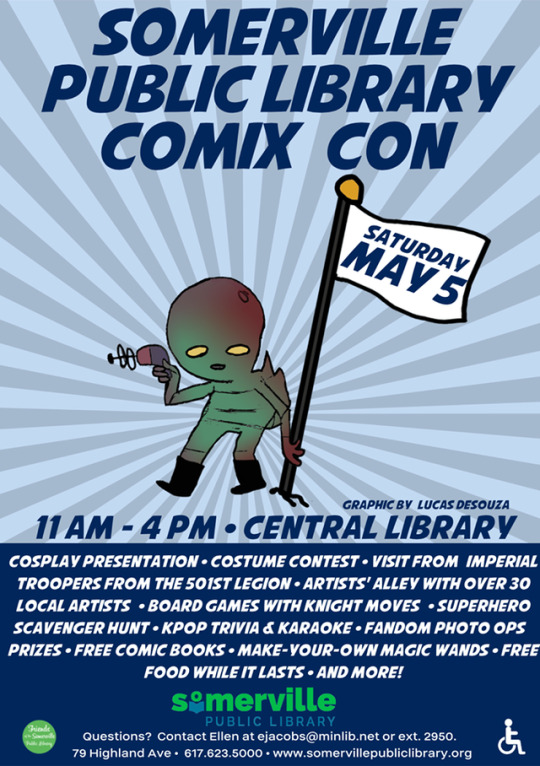
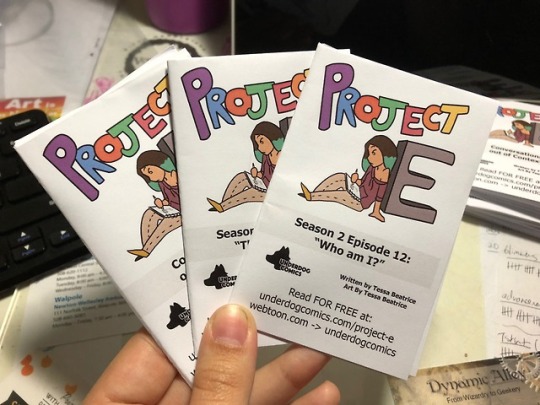
Who's ready for Free Comic Book Day this Saturday? At select stores, you can find free Project E pamphlets as well as free copies of Placement: Chapter One of Fury's Forge!
They can be found at:
Our booth at the Somerville Public Library ComicCon
Omar’s World of Comics and Games in Lexington
Outer Limits in Waltham
Comicazi in Somerville
The Million Year Picnic in Cambridge
#comics#comic books#fcbd2018#free comic book day#somerville public library#comiccon#omar's world of comics and games#outer limits#comicazi#the million year picnic#slice of li#action#adventure#project e#furysforge#lgbt#feminist#minority
5 notes
·
View notes
Text

Want to learn about turtles in New England, what they face and how we can help? Check out this awesome zoom event being held by the Somerville MA public library!
You don’t have to be in Somerville to attend! Just sign up and join on Zoom! For the turtles and for SCIENCE!
https://somervillepubliclibrary.assabetinteractive.com/calendar/turtle-talk-with-ben-phillips/
#tortoise#turtle#turtpocalypse#animals#shell#herpetology#chelonian#cute#pets#reptiblr#tortblr#reptile
5 notes
·
View notes
Text
David's 2022 foraging tours
May 11, Newton community education, 5:30pm
May 21, 10:30 am. Arlington forage, https://www.arlingtoncommunityed.org.
June 4, 10:30 am Gibbet Hill Grill, Groton, MA
June 8, 4:30 pm, in Kendall Sq, sponsored by High Profile.
June 9, BU with Netta Davis.
June 18, 11am-12:30 Forage Needham.
Private event Aug 2 with Toast.
Youth foraging private with Somerville Mayor's program, Aug 8.
Sept 15, 4:30pm, foraging tour for High Profile/ULI Boston/New England Urban Agriculture, downtown Boston.
Oct 16, 10 am Needham adult ed.
Oct 22, Arlington public library
2 notes
·
View notes
Photo


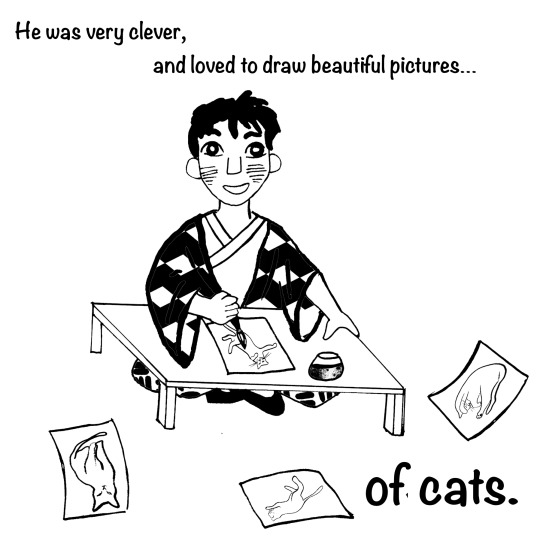







Exercise: Once upon a time
For some time I researched different folk tails and fairy stories as I didn’t want to do a tale that was very common especially in English story telling. I came across the story of ‘The Boy Who Drew Cats’ ( 猫を描いた少年).
The story
The Japanese tale was about a boy who does nothing but draw cats. Sent away by his farming family to a temple to learn from a priest he continues to draw only cats. The priest tells the boy that he will not be a priest but on day may become a successful artist. The boy is asked to leave and given the advice ‘Avoid large places at night - Keep to the small’.
The boy decides he won't return home and seeks shelter in another large temple which unbeknownst to the boy was abandoned after an attack from a large rat goblin. Walking around the empty temple he decides to draw cats on the walls. Remembering the priest’s advice when night falls finds a cupboard to sleep in. Through the night he hears loud screeching.
When he wakes and leaves the cupboard he sees the rat goblin dead on the floor and his cat illustrations mouths filled with blood. The people of the town rejoice that the rat goblin has been killed and the boy becomes a successful artist as the priest had told.
Re-tellings in English
I accessed a scanned copy of a translation of the story by Lafcadio Hearn circa 1898. I also read a more modern retelling by Aaron Shepherd from 1998. Both these versions helped me get a good understanding of the story.
https://digitalcollections.nypl.org/items/510d47d9-49f8-a3d9-e040-e00a18064a99/book#page/1/mode/2up
http://www.aaronshep.com/stories/045.html
My partner, who is a creative writing student, kindly rewrote the story for me so that it was clear and flowed well.
Approaching the story
I felt the story could be broken down into key areas.
Setting
Farm
Temple
Large Temple
Cupboard (possibly?)
Characters
Boy
Family
Preist
Rat Goblin
I really wanted my illustrations to flow with the text, like many modern children books, not simply the text on one page and the illustration on the other. I wanted to use Japanese stylised elements to tie the setting of the story to the illustration. I researched Japanese architecture, pattern design and drawing motifs which helped influence my illustrations. (All are referenced at the end of this post) I asked my friends to send me photos of their cats for drawing reference.
Cat reference
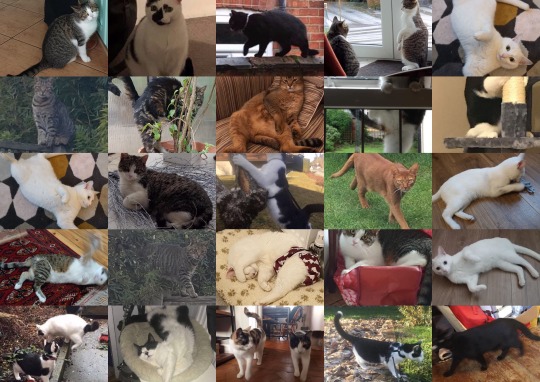
Illustrations from ‘Treasury of Japanese Designs and Motifs’
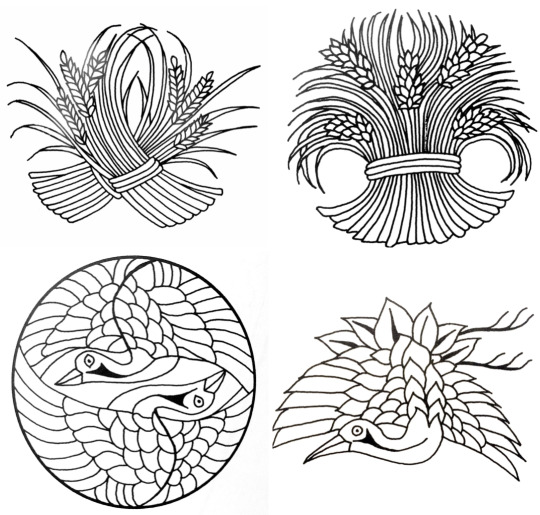
Sketches and drawings
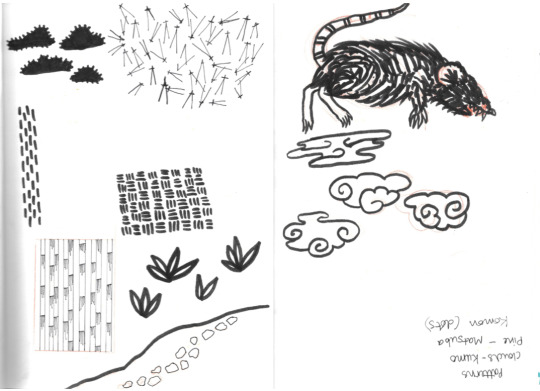
I really like rats, my first rat was too cute and I had to rethink the body shape to make him seem more scary.
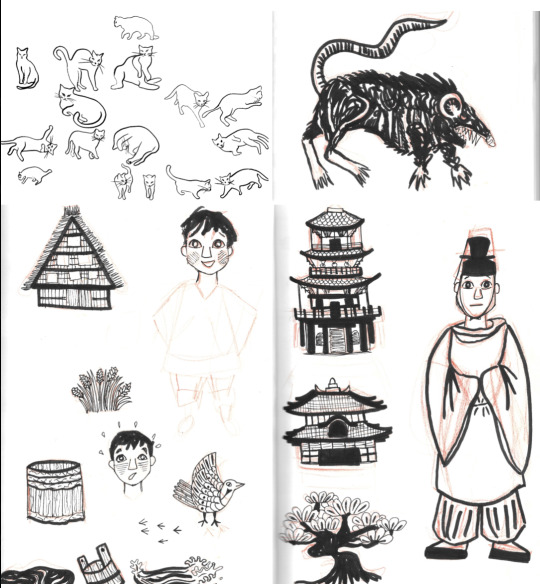
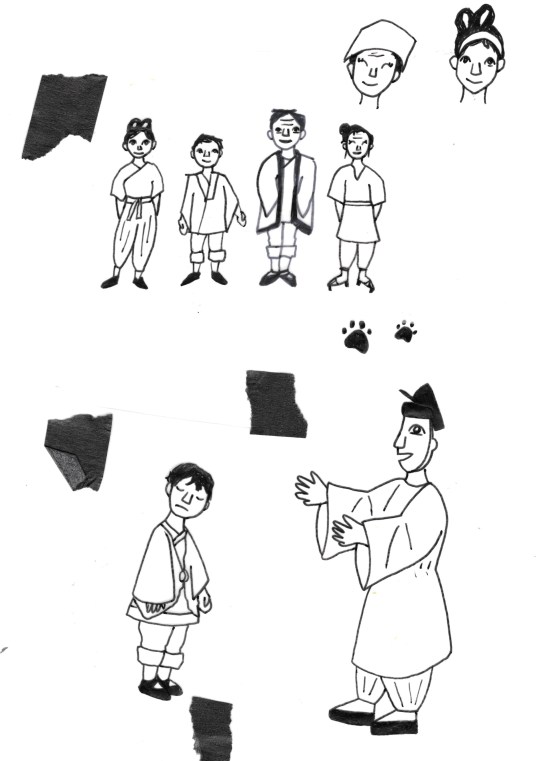
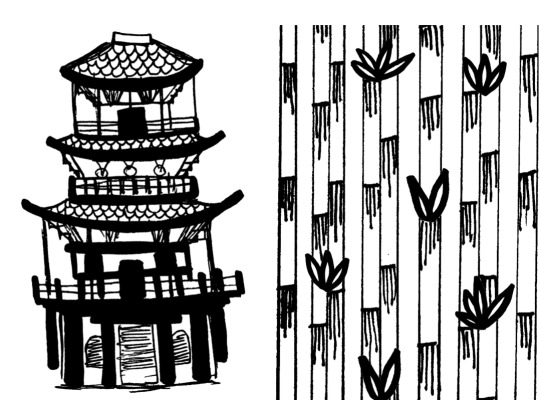
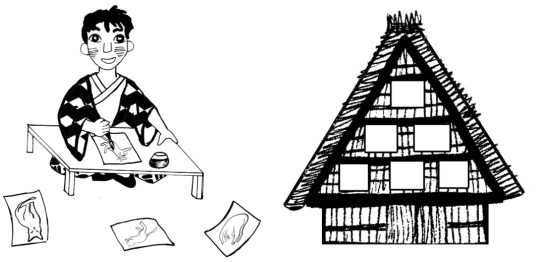
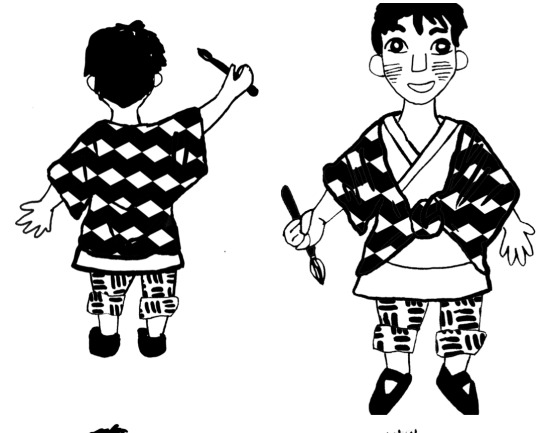
Completed Story
I wanted the text and illustration to work together and enhance the rhythm of the reader.



I played with the text size to emphasis key points.



By exploiting the reading direction of left to right up to down, I staggered the text and illustration to cause the reader to explore the whole page. It also slows the reading speed and adds a pause between each point as the reader processes the illustration.




Although not strictly an illustration I couldn’t help but include this page. I wanted to convey the protagonists emotion by having no illustration, lots of negative space and the text central.




I chose not to depict the ‘fight’ to leave the reader to fill in the gaps in the story. It is a key part of the development of language and reasoning (blooms taxonomy) for children to be able to use the visual clues and written text to deduce what has happened within the narrative. I wanted to use this as a discussion point between young readers and their adult support. This is a strategy used in many chickens books, This is not my hat, Jon Klassen being the most recent that I have read.
youtube


I feel my illustrations interact with the text well, adding to the story but also having their own breathing space. Overall I think the exercise has been very successful and the protagonist is engaging and likeable.
References
2020. Farmer Clothing. [image] Available at: <https://realjapanesegardens.files.wordpress.com/2016/05/for-wordpress-post-11.jpg> [Accessed 6 April 2020].
2020. Japanese Scribe. [image] Available at: <https://www.gettyimages.co.uk/detail/illustration/japanese-scribe-royalty-free-illustration/482658975?language=fr> [Accessed 6 April 2020].
2020. Shinto Priest. [image] Available at: <https://www2.kokugakuin.ac.jp/ijcc/wp/bts/bts_s.html> [Accessed 6 April 2020].
2020. Tall Temple. [image] Available at: <https://www.sovereignman.com/trends/after-1428-years-heres-what-brought-down-the-worlds-oldest-business-18654/> [Accessed 6 April 2020].
2020. Temple. [image] Available at: <https://en.wikipedia.org/wiki/Main_Hall_(Japanese_Buddhism)#/media/File:Tōdai-ji_Kon-dō.jpg> [Accessed 6 April 2020].
2020. Traditional Clothing. [image] Available at: <https://www.agefotostock.com/age/en/Stock-Images/Rights-Managed/IBR-2353348> [Accessed 6 April 2020].
2020. Traditional Farm House. [image] Available at: <https://en.wikipedia.org/wiki/Minka#/media/File:Shirakawago_Japanese_Old_Village_001.jpg> [Accessed 6 April 2020].
2020. Traditional Peasant Clothing. [image] Available at: <http://nariyuki-circus.com/kikaku/5323/> [Accessed 6 April 2020].
Duende by Madam ZoZo. 2020. Decoding The Meaning Of Wagara - Traditional Japanese Patterns. [online] Available at: <https://duendebymadamzozo.com/traditional-japanese-patterns/> [Accessed 6 April 2020].
General Research Division, The New York Public Library. "The boy who drew cats" New York Public Library Digital Collections. Accessed March 7, 2020. http://digitalcollections.nypl.org/items/510d47d9-49f8-a3d9-e040-e00a18064a99
Grafton, C., 1983. Treasury Of Japanese Designs And Motifs For Artists And Craftsmen. New York: Dover.
Historyinphotos.blogspot.com. 2020. Vintage Japan. [online] Available at: <http://historyinphotos.blogspot.com/2014/01/vintage-japan.html> [Accessed 6 April 2020].
Japan-guide.com. 2020. Kyoto Travel: Tenryuji Temple. [online] Available at: <https://www.japan-guide.com/e/e3913.html> [Accessed 6 April 2020].
Klassen, J., 2012. This Is Not My Hat. Somerville, Mass.: Candlewick Press.
Kiriko Made. 2020. 和柄 : Japanese Patterns - Part 1. [online] Available at: <https://kirikomade.com/blogs/our-fabrics/japanese-patterns-1> [Accessed 6 April 2020].
Manila Bulletin News. 2020. With Sake And Shinto Rites, Japanese See In New Era. [online] Available at: <https://news.mb.com.ph/2019/05/01/with-sake-and-shinto-rites-japanese-see-in-new-era/> [Accessed 6 April 2020].
3 notes
·
View notes
Text
AI in Classrooms... Motivating or Intrusive? - Josh Lang
Classrooms in China are leading the way in terms of utilising smart technology, but it is raising questions from outsiders about privacy and long-term practicality. Of course, we have heard of using smart robots for reading stories to children or creating personalised lesson plans. However, the AI used in China currently is going far beyond robot relationships. Somerville, Massachusetts based company BrainCo has been working closely with Chinese school systems to create brainwave-reading headbands that children wear during their time at school. These headbands use multiple neuron-detecting sensors located on various parts of the head in order to track to key metrics about everything from a students attention span in class to how loudly they are speaking. Although studies have collected data that back up these uses of this technology, there is no shortage of ethical concerns and opposition to this movement.

The Wall Street Journal describes a typical day of a student in China and how the brainwave-reading headbands has affected their learning. While many students in America and other countries around the world may start their day by opening their textbooks, or taking out last night’s homework, the day of a Chinese student begins by putting on their headband. The day then starts with a short meditation session where students are able to see and measure just how deep into a state of meditation they can go. Following mediation is a short attention training competition. Many games have been created using the headbands as controllers where students can compete on the board in the front of the classroom simply by thinking. In one instance of this, students try to concentrate as hard as possible to get their rocket to fly higher than other student’s rockets. The goal of this is to get students in the mindset of concentration, and teachers have actually reported positive findings in terms of how much students are paying attention in class.
These headbands also have more practical and measurable initiatives as well. As pictured in the image above, the headbands have coloured strips on the front of them which indicate the level of attention the kids are paying. Teachers at the front of the classroom not only can see this information, but also have a live feed of personalised information on their computer in the front of the class. They can see which kids are paying attention at which times, who is talking, and even detect body language and gestures of students at all times. Although teachers can use this information to detect which activities and lessons are the most effective, it puts a large strain on the stress of children. While teachers are getting real time information at the front of the classroom, parents are receiving live feeds of their children’s attention to their phones. Many kids have reported punishments at home for “poor attention ratings” and feel extremely pressured to perform better in the classroom. Although this has raised overall grades, and teachers report improved performance, many critics have been outspoken about the issue.

Critics have drawn comparisons to outside sources including ancient folklore and modern day surveillance technology in Beijing. In ancient Chinese folklore, a golden ring is places on the heads of those who disobey and it instantly turns them in to orderly citizens. Drawing on these old narratives has provided critics with a point from the past which warns about losing a sense of identity and freedom. In a modern contrast, AI and technology in Chinese schools has been compared to a similar surveillance of citizens in Beijing which has been in the public eye as an invasion of privacy. Along with the headbands on every student, some schools have implemented facial recognition cameras and motion sensors around the school. These cameras and sensors track facial expressions and students locations all around the school. All time spent in the library vs the classroom vs the playground is monitored and tracked.

Although many westerners and people in other parts of the world may instantly have a negative reaction towards this type of extreme monitoring, people in China who have first hand experience with this actually do not seem to mind. Parents have reported positive reviews of this technology because it allows them to be more in control of their children’s education. Many people in this culture have subscribed to the idea that giving up data for the betterment of society is okay. While something this invasive almost certainly would not fly in America, China is using this technology in a societally approved manner for the betterment of education. It will be interesting to see the extent to which Americans will adopt this technology and put it to use here.
Sources:
https://www.wsj.com/video/under-ais-watchful-eye-china-wants-to-raise-smarter-students/C4294BAB-A76B-4569-8D09-32E9F2B62D19.html?mod=article_inline
https://www.wsj.com/articles/chinas-efforts-to-lead-the-way-in-ai-start-in-its-classrooms-11571958181
https://www.scmp.com/news/china/politics/article/3027349/artificial-intelligence-watching-chinas-students-how-well-can
6 notes
·
View notes
Text
ambridge Community Television
ambridge Community Television (CCTV) has help the town since its inception in 1988. CCTV cause Cambridge's common access telly dexterity and three boob tube sweal, 8, 9, and 96, on the Cambridge cord system (Comcast). The city has summon tenders from other cord providers, but Comcast remains its only established television and broadband utility, though services from American satellite TV providers are ready. In October 2014, Cambridge City Manager Richard Rossi appointed a burgher Broadband Task Force to "scrutinize alternative to aggravate competition, subdue rate, and ameliorate velocity, reliableness and buyer benefit for both residents and businesses."
Cambridge Mask’s™ filtration system, incorporating particulate percolate belt and sword change carbon match N99 flag of particulate filtration, supply about 100% refuge from particularize impurity such as PM2.5 and PM0.3.
The town of Cambridge is protected by the Cambridge Fire Department. Established in 1832, the CFD exercise eight engine companies, four run association, one deliver company, and two paramedic relay association from eight fire stations located throughout the burg. The Acting Chief is Gerard Mahoney.
Through the City of Cambridge's exclusive city calender system, the city further counteract two exclave areas, one being Payson Park Reservoir and Gatehouse, a 2009 enrolled American Water Landmark set austerely one mile west of Fresh Pond and hem in by the city of Belmont. The another area is the larger Hobbs Brook and Stony Brook watersheds, which share borders with neat towns and cities conclude Lexington, Lincoln, Waltham and Weston.
Personalise your bag Make a singular pouchy accurately unique - add your name, initials, flat anything you'd preference. Find out more Visit our boutique Magnificent as our website is, you can't beat sighted, adjacence (and smelling!) the regal thing. Come and see us, it's worth the trip. Find out more What fits in your belly Size importance. Find your complete belly by obstruction out our at hand guide. Find out more
Visit our store Magnificent as our website is, you can't beat seeing, moving (and smelling!) the kingly appurtenances. Come and see us, it's worth the trip. Find out more
Le truncheon de football de Cambridge, le Cambridge United Football Club, a mirthé en distribution nationale anglaise de 1970 à 2005 dans son antre de l'Abbey Stadium, avant d'être relégué en Conférence. Quand la relégation est devenue inévitable, le truncheon fut placé sous conduct judiciaire, victime de dettes importantes, maiden la gestion financière du bastinado east redevenue saine lors de la saison 2005/2006.
L'arrivée des Vikings dans Cambridge a été enregistrée dans la Chronique anglo-saxonne en 875. La loi viking, la Danelaw, a été imposée en 878. Les fortes habitudes commerçantes des Vikings ont permis à Cambridge de grossir rapidement. Pendant cette période, le centre de la ville s'east déplacé de Castle Hill sur la rive winding de la rivière à un endroit appelé Quayside sur la rift droite. Après la vane de la période Viking, leash Saxons sont revenus brièvement au pouvoir, construisant notamment l'élapse Saint-Bene't en 1025. Elle est toujours visible dans Benet's Street.
We tender a spacious frequent of inferior, with pliant ways to offer them. Our Cambridge Primary and Lower Secondary playbill now include four new subjects, giving our schools a comprehensive and balanced course.
Try our lively, unreserved online proof to find out what your clear of English is, and which Cambridge English Qualification might be best for you. There are judgment set for every level, and at the end you will get recommendations on how to mend your English.
Cambridge (/ˈkeɪmbrɪdʒ/ KAYM-brij) is a city in Middlesex County, Massachusetts, and part of the Boston metropolitan area. As of July 2018[update], it was the ⅕ most populous city in the state, behind Boston, Worcester, Springfield, and Lowell. According to the 2010 Census, the city's population was 105,162. It is one of two de jure shire seats of Middlesex County, although the count's direction was nullify in 1997. Situated directly en of Boston, across the Charles River, it was denominate in honor of the University of Cambridge in England, once also an necessary hub of the Puritan divinity embraced by the town's fall.:18
Further educational office are if at the Cambridge Public Library. The copious modern main building was framed in 2009, and connects to the restored 1888 Richardson Romanesque building. It was founded as the privy Cambridge Athenaeum in 1849 and was cultivated by the village in 1858, and became the Dana Library. The 1888 construction was a donation of Frederick H. Rindge.
Il existe un autre basto de football à Cambridge, basé dans le quartier de Chesterton, le Cambridge City F.C. qui joue dans la variance juste inférieure, dans son stadium, le City Ground.
Together we inspire learners to go further Our sift of immoderate education resort, lesson plans and activities is sketch to remedy you framed your students for our exams and proof. We also have a range of teaching qualifications, succession and nourish to help you develop as a lickpot.
According to the United States Census Bureau, Cambridge has a total extent of 7.1 quarrel miles (18 km2), of which 6.4 square miles (17 km2) is catch and 0.7 level miles (1.8 km2) (9.82%) is moisten.
In 1976, Harvard's plans to empty proof with recombinant DNA led to a three-lunation moratorium and a effeminate revision panel. In the end, Cambridge unquestionable to permit such experiments but care safeness regulations in 1977. This led to regulatory certainty and acceptance when Biogen open a lab in 1982, in oppose to the warfare that caused the Genetic Institute (a Harvard spinoff) to resign Somerville and Boston for Cambridge. The biotech and pharmaceutical industries have since batten in Cambridge, which now includes head office for Biogen and Genzyme; laboratories for Novartis, Teva, Takeda, Alnylam, Ironwood, Catabasis, Moderna Therapeutics, Editas Medicine; protect crew such as Cytel; and many smaller assembly.
La ville et l'université sont étroitement imbriquées. Il n'y a pas, contrairement au schéma classique, de campus propre à l'université. La ville et l'université s'étant développées simultanément depuis 800 in addition to, de nombreux bâtiments (laboratoires, amphithéâtres, bâtiments administratifs, bibliothèque) sont disséAmoyés au sein de la ville, le centre historique étant bien sûr occupé by leash collèges ou laboratoires les plus anciens.
Choose a topic, or make your own Write & Improve lets you increase through a difference of topics at Beginner, Intermediate and Advanced just. Or create your own tasks, based on your excite or preparation, and Write & Improve will proof them.
As of the census of 2010, there were 105,162 people, 44,032 households, and 17,420 families residing in the city. The population density was 16,354.9 people per square mile (6,314.6/km²). There were 47,291 housing one at an run compactness of 7,354.7 per squadron mile (2,840.3/km²). The racial arrangement of the town was 66.60% White, 11.70% Black or African American, 0.20% Native American, 15.10% Asian (3.7% Chinese, 1.4% Asian Indian, 1.2% Korean, 1.0% Japanese), 0.01% Pacific Islander, 2.10% from other races, and 4.30% from two or more breed. 7.60% of the population were Hispanic or Latino of any race (1.6% Puerto Rican, 1.4% Mexican, 0.6% Dominican, 0.5% Colombian, 0.5% Salvadoran, 0.4% Spaniard). Non-Hispanic Whites were 62.1% of the population in 2010, down from 89.7% in 1970. An distinctive fixed of Cambridge is 파워볼전용사이트 as a Cantabrigian.
Des campements ont existé autour du lieu avant l'kingdom romain. La première preuve trouvée d'une tenure, une assemblage d'forearmed de chasse, place de l'âge de impudence qui commence à environ 1000 av. J.-C. Il y a d'autres trouvailles fornixéologiques d'objets datant de l'âge de fer, une tribu belge ayant débarqué à Castle Hill au Ier siècle av. J.-C..
1 note
·
View note